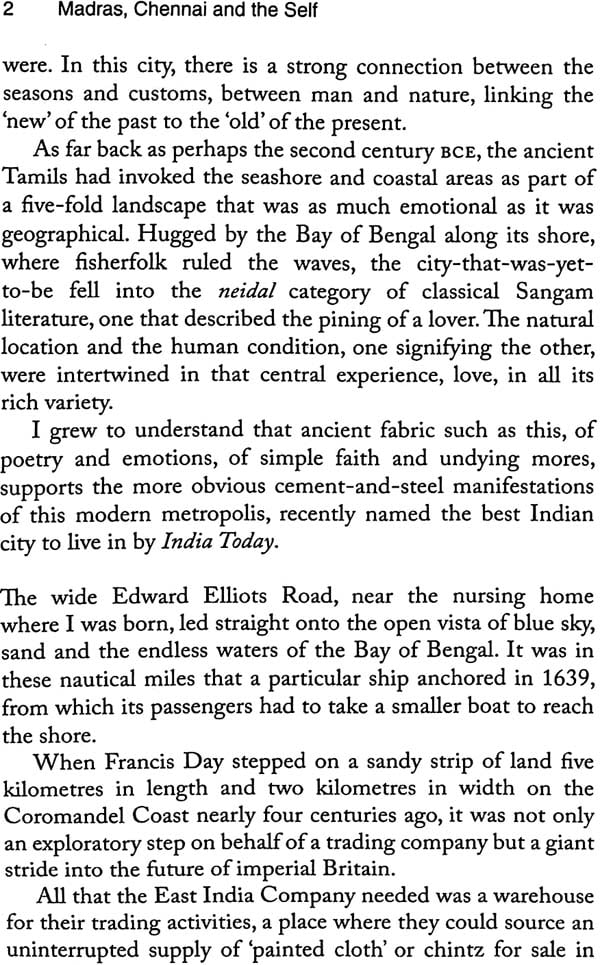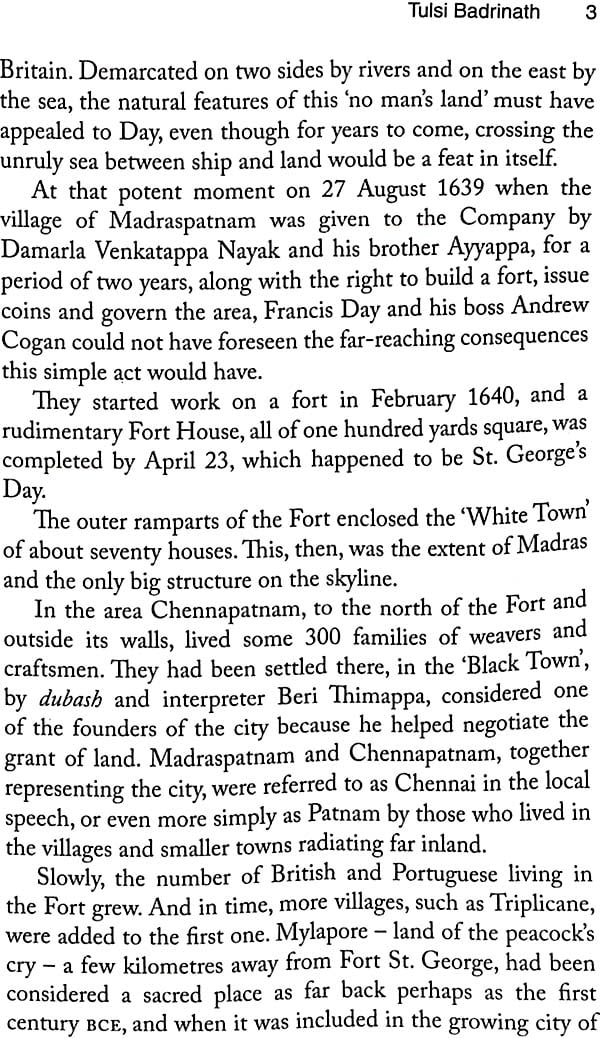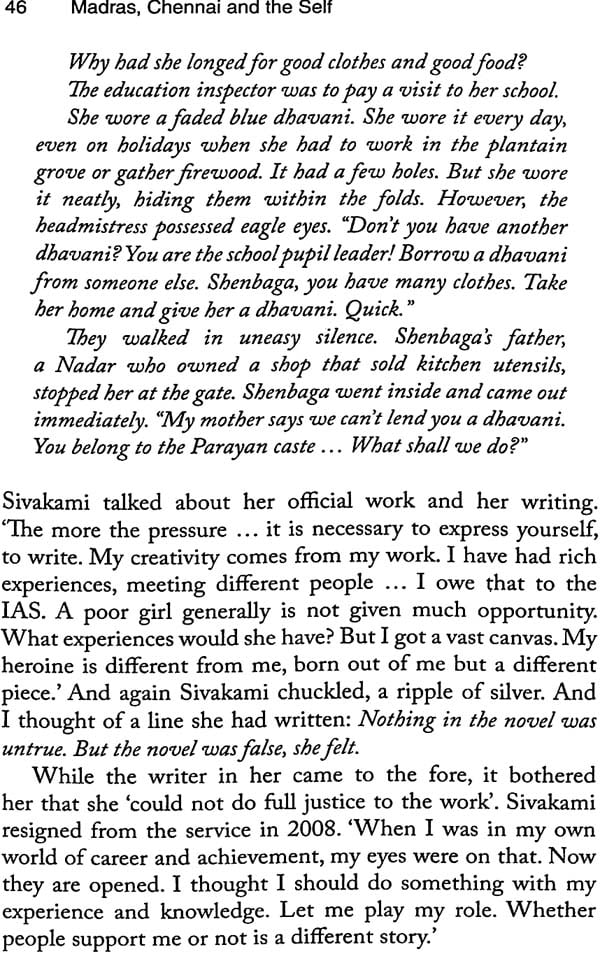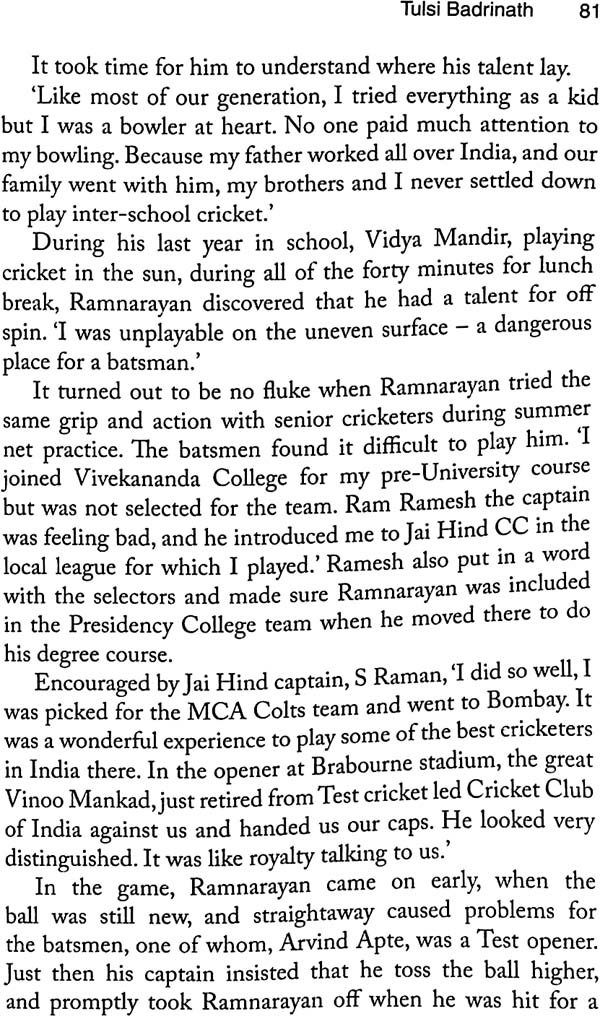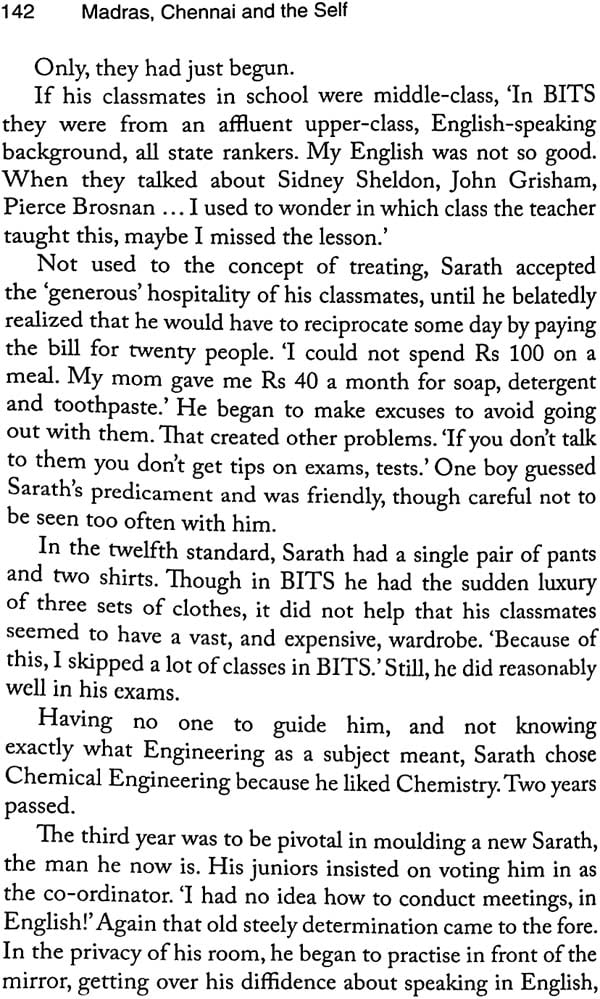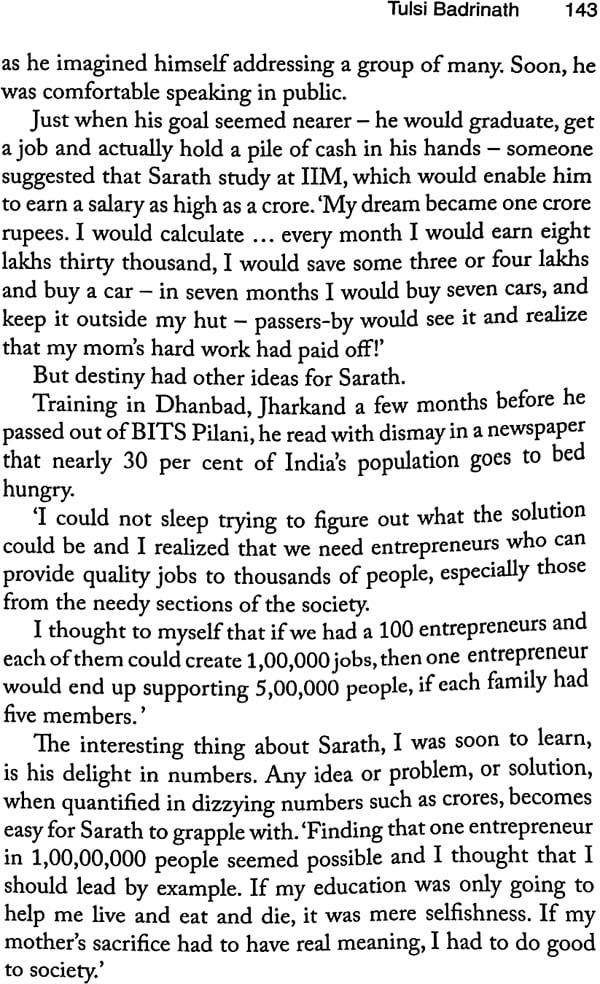
Madras, Chennai and The Self Conversations With The City
Book Specification
| Item Code: | NAP147 |
| Author: | Tulsi Badrinath |
| Publisher: | Macmillan India Ltd |
| Language: | English |
| Edition: | 2015 |
| ISBN: | 9789382616238 |
| Pages: | 234 |
| Cover: | Paperback |
| Other Details | 8.0 inch X 5.5 inch |
| Weight | 180 gm |
Book Description
In a metropolis where customs are paramount, humanity essential the evil eye feared and showing off considered distasteful, how do people navigate the streams of tradition and modernity? How does the self form a lasting equation with the city? Some do it with ease, some with effort, but they all have a special love for the city – for a tradition they find organic and lived, for the co-existence of various religions; for the distinct sense of community and neighbourhoods; for the spacious inner life.
In Madras, Chennai and the Self: Conversations with the city, Tulsi Badrinath creates a layered image of Chennai by sifting through her memories, and by narrating the stories of those who call it home – the current Prince of Arcot, Dalit writer and activist P Sivakami, superstar Vikaram and karate-expert K Seshadri, among others.
In their words come alive key aspects of the city – the fine beaches along the Bay of Bengal, Fort St. George, coconut and mango trees, jasmine stalls, cricket fever, classical music and dance, the twin temptations of idli and dosai, temple crowds and radical twin temptations of idli and dosai, temple crowds and radical political movements.
About The Author
Born in 1967 in Madras, Tulsi Badritnath has a Bachelor’s degree in English Literature form Stella Maris College and an MBA from Ohio University, Athens four long, dreary years in a multinational bank, Tulsi quit her job to pursue her passion for writing and dance.
Her birthplace is also her chosen home. The city has always been central to Tulsi’s work – Madras, Chennai and the Self: Conversations with the City in her fourth book on the subject, adding substantially to the Madras body of work that includes two novels, Meeting Lives and Man of A Thousand Chances, both novels, Meeting Lives and Man of A Thousand Chances, both longisted for the Man Asian Literary Prize, and one of narrative non-fiction, Master of Arts, A Life in Dance.
Her poems, articles, reviews and short stories have appeared in India Today, The Week, the Hindu, New Indian Express, Deccan Herald and Namaste among others.
Tulsi was trained in Bharatantyam from the age of eight by the Dhananjayans , and has performed solo widely, in India and abroad.
Introduction
One of my earliest memories of Madras is of oil lamps radiant in the dusk, just outside the compound of our house.
There, on the other side of the hedge, visible during the day and worshipped at night, were several anthills, long cones of mud with snake burrows underground. In the evening, passers-by lit oil lamps, poured milk and left eggs at the shrine of the snake gods. Warm flames flickered at dusk, rendering alive the primordial mounds adorned with red kumkum and red hibiscus flowers. When it turned dark, the golden light wavered in the wind, conical shadows turned taller and there was a palpable sense of the snakes.
The anthills had sprung up recently, as also the shrine similar to other scattered throughout the city at the root of old trees in grows, r those by the road. At some point, my father, irked by the increasingly large, noisy gatherings just ouside our gate and the imminent possibility that they would encroach on public land and build a permanent shrine, or perhaps worried that there were indeed snakes so close to our home, ordered the hillocks to be razed. No one protested. The holes were filled up, and that evening there was only absence, the darkness, and thwarted, puzzled wayfarers who carried their offerings home.
This deep-rooted memory carries within in the sense of something enduring, beyond all the – dusk, the gesture of setting a wick alight, the basic sustenance from soil, veneration of forces larger than oneself, the juncture of night and day. Each passing year added layer upon layer of other similar memories a vertical connection between sky and earth as it were. In this city, there is a strong connection between the season and customs, between man and nature, linking the ‘new’ of the past to the ‘old’ of the present.
As far back as perhaps the second century BCE, the ancient Tamils had invoked the seashore ad coastal areas as part of five-fold landscape that was as much emotional as it was geographical. Hugged by the Bay of Bengal along it shore, where fisherfolk ruled the waves, the city-that –was –yet –to-be fell into the neidal category of classical Sangam literature, one that describe the pining of a lover. The natural location and the human condition, one signifying the others, were intertwined in that central experience, love, in all its rich variety.
I grew to understand that ancient fabric such as this, of poetry and emotions, of simple faith and undying mores, supports the more obvious cement-and-steel manifestations of his modern metropolis, recently named the best Indian city to live in by India Today.
The wide Edward Elliots Road, near the nurshing home where I was born, led straight onto the open vista of blue sky, sand and the endless waters of the Bay of Bengal. It was in these nautical miles that a particular ship anchored in 1639, from which Its passengers had to take a smaller boat to reach the shore.
When Francis Day stepped on a sandy strip of land five kilometers in length and two kilometres in width on the Coromandel Coast nearly four centuries ago, it was not only an exploratory step on behalf of a trading company but a giant stride into the future of imperial Britain.
All that the East India Company needed was a warehouse for their trading activities, a place where they could source an uninterrupted supply of ‘painted cloth’ or chintz for sale in Britain Demarcated on two sides by rivers and on the east by the sea, the natural features of this ‘ no man’s land’ must have appealed to Day, even though for years to come, crossing the unruly sea between ship and land would be a feat in itself.
At that potent moment on 27 August 1639 when the village of Madraspatnam was given to the Company by Damarla Venkatappa Nayak and his brother Ayyappa, for a period of two years, along with the right to build a fort, issue coins and govern the area, Francis Day and his boss Andrew Cogan could not have foreseen the far-reaching consequences this simple act would have.
They started work on a fort in February 1640,and a rudimentary Fort House, all of one hundred yards square, was completed by April 23, which happened to be St George’s Day.
The outer ramparts of the Fort enclosed the ‘White Town’ of about seventy houses. This, then, was the extent of Madras and the only big structure on the skyline.
In the area Cheenapatnam, to the north of the Fort and outside its walls, lived some 300 families of weavers and craftsmen. They had been settled there, in the ‘Black Town’, by dubash and interpreter BEri Thimappa, considered one of the founders of the city because he helped negotiate the grant of land. Madraspatnam and Chennapatnam, together representing the city, were referred to as Chennai in the local speech, or even more simpleyas Patnam by those who lived in the villages and smaller towns radiating far inland.
Slowly, the number of British and Portuguese living in the fort grew. And in time, more villages, such a sTriplicane, were added to the first one. Mylapore – land of the peacock’s cry – a few kilometres away from Fort St. George, had been considered a sacred place as far back perhaps as the first century BCE, and when it was included in the growing city of Madras, it also became one of its oldest localities. All these villages lay outside the boundary of the Fort, and as the city of Madras grew to its present size, so did the number of villages included within its greater area, while the Fort itself did not grow substantially past its outer perimeter of about himself red acres.
Contents
| Introduction | 1 | |
| 1 | The Indiidual and the Collective | 10 |
| K Seshavari | ||
| 2 | Power of the Pen | 29 |
| P Sivakami | ||
| 3 | Coping with Change | 50 |
| Saravana Sakthivale | ||
| 4 | Inheriting History | |
| Nawab Mohammed Abdul Ali,The Eight | 65 | |
| Prince of Arcot | ||
| 5 | Of Old and New Traditions | 75 |
| V Ramnarayan | ||
| 6 | Enriching Cultures | 95 |
| Dr Beatrix D'Souza | ||
| 7 | Thinnais and Inner Spaces | 115 |
| M Krishnan | ||
| 8 | Of Hunger and Riches | 134 |
| Sarathbabu Elumalai | ||
| 9 | Reaching for the Stars | 153 |
| Vikram | ||
| 10 | The Birth of a Citizen | 170 |
| Dr Uma Ram | ||
| 11 | Building Peace | 190 |
| A Faizur Rahman | ||
| 12 | Wired and Wireless | 206 |
| Kuruba Shankar | ||
| Afterword | 221 | |
| Select Bibliography | 230 | |
| Acknowledgement | 231 |
